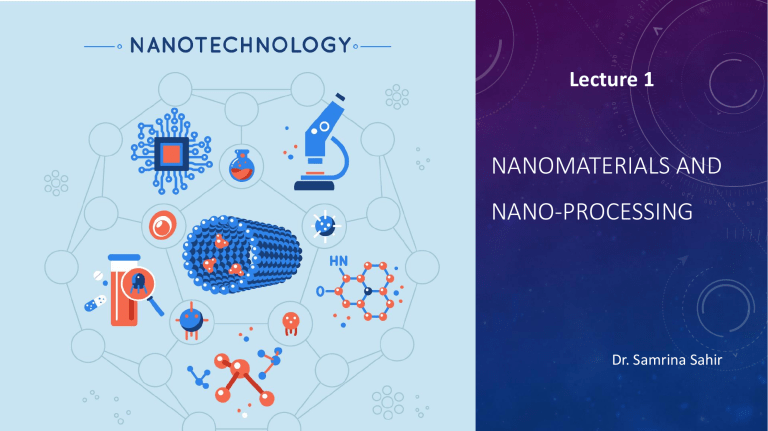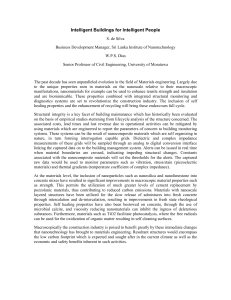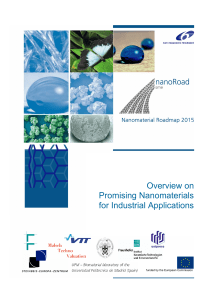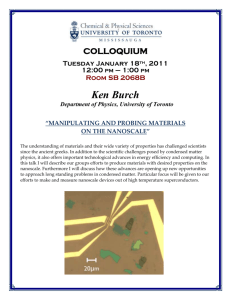
Lecture 1 NANOMATERIALS AND NANO-PROCESSING Dr. Samrina Sahir OUTLINE OF THE COURSE CONTENT 1. Introduction to Nanomaterials ✓ Magnetic Properties 2. Quantum Mechanics and Atomic Structures ✓ Optical Properties 5. Characterization of Nanomaterials 3. Bonding and Band structures in solids ✓ X-Ray Diffraction 4. Nano materials fabrication ✓ Electron Microscopy for Nanomaterials Characterization (SEM, TEM, SPM) ✓ Bottom-up approaches ✓ Top-down approaches 5. Properties of nanomaterials ✓ Mechanical Properties ✓ Surface Analysis Methods (Auger Electron Microscope AES, XPS, Secondary Ion Mass Spectroscope SIMS) 6. Applications of nanomaterials ✓ Nanoelectronic materials ✓ Nanobio materials ✓ Nanostructural materials WHAT IS NANOMATERIAL? ✓ The term nano derives from the Greek word for dwarf. Nanomaterials are commonly defined as materials with an average grain size less than 100 nanometers (One billion nanometer equals one meter (10¯⁹ m = 1 nm)) ✓ Nanomaterials have extremely small size which having at least one-dimension of 100 nm ✓ Nanotechnology exploits benefits of ultra small size, enabling the use of particles to deliver a range of important benefits such as ✓ Small particles are ‘invisible’ → Transparent coatings/films are attainable ✓ Small particles are very weight efficient → Surfaces modification with minimal material ✓ The average width of a human hair is on the order of 100,000 nanometers ✓ A single particle of smoke is in the order of 1,000 nanometers ✓ DNA : 2.5 nm ✓ Hb : 6.5 nm ✓ Viruses : 10-100 nm TYPES OF NANOSTRUCTURES • Nanomaterials can be nanoscale in • One dimension (surface films) • Two dimensions (strands or fibers) • Three dimensions (particles) • They can exist in single or fused forms with spherical tubular, and irregular shapes WHY NANOMATERIALS? • Large spherical particles do not cover much surface area. Nanoparticles equal mass of small platelet particles provides thorough and uniform coverage • By patterning matter on the nanoscale, it is possible to vary fundamental properties of materials without changing the chemical composition • Applications of nanomaterials include • Nanophase ceramics • Nanostructured semiconductors • Nanosized metallic powders • Single nanosized magnetic particles • Nanostructured metal-oxide thin films APPROACHES TO NANOMATERIAL SYNTHESIS • Two approaches are used • Top-down approach: Breaking down matter into more basic building blocks. Frequently uses chemical or thermal methods. The example includes the production of integrated circuits by etching or lithography and mechanical grinding. • Bottom-up approach: Building complex systems by combining simple atomic level components. The commonly used methods include sol-gel, hydrothermal, physical and chemical vapor deposition, epitaxial growth. THE ORIGINS OF NANOTECHNOLOGY 1. The word “Nanotechnology” was first used by Norio Taniguchi in 1974 in a paper entitled “On the Basic Concept of ‘Nano-Technology’ to refer to “the technology that engineers materials at the nanometer level” 2. “ ‘Nano-technology’ is the production technology to get the extra high accuracy and ultra fine dimensions, i.e., the preciseness and fineness of the order of 1 nm (nanometer), 10¯⁹ m in length. With materials the smallest bit size of stock removal, flow, or design is one atom (generally about 1/5th of a nanometer), so the limit of fineness of materials is on the order of one nanometer.” Taniguchi imagined that ion sputtering would be the most promising process for the technology. 3. In 1981, Drexler described a new “bottom up” techniques instead of “top down” in 1987, K. Eric Drexler published his book, Engines of Creation: The Coming Era of Nanotechnology. Aimed at a non-technical audience while also appealing to scientists, Drexler’s book was a highly original work describing a new form of technology based on molecular “assemblers,” which would be able to “place atoms in almost any reasonable arrangement” and thereby allow the formation of “almost anything the laws of nature allow.” THE ORIGINS OF NANOTECHNOLOGY 4. Tools developed to handle individual atoms, such as the Scanning Probe Microscope at IBM, enabled researchers to study and manipulate individual atoms and molecules with a degree never before possible. 5. The discovery of novel materials on the nanoscale notably began with the Buckminsterfullerene (also called the buckyball). The buckyball was so named because of the resemblance to the geodesic domes that the architect Richard Buckminster Fuller popularized. Discovered in 1985 at Rice University, it consists of an arrangement of 60 carbon atoms. 6. In 1991, Nanoscale materials became the focus of intense research with the discovery of the carbon nanotubes by Sumio Iijima of NEC. 7. In 2000, the US government developed the National Nanotechnology Initiative (NNI) to administer funding and develop nanotechnology as the major research thrust of the twenty first century. THE CURRENT STATE OF NANOTECHNOLOGY • Current direction of nanotechnology research 1. Nanoscale science (the science of interaction and behaviors at nanoscale) 2. Nanomaterials development (the actual experimental development of nanoscale materials, including their use in device applications) 3. Modeling (computer modeling of interactions and properties of nanoscale materials) • Nanotechnology today focuses on the development, understanding, and use of materials at the nanoscale, or nanomaterials. Materials are made up by an arrangement of atoms – typically in a specific way – which helps define the property of the material. 1. NANOSCALE SCIENCE • The laws of physics that operate on objects at the nanoscale combine classical (or Newtonian) mechanics, which governs operations of everyday objects, and quantum mechanics, which governs the interactions of very small things. • Quantum mechanics works at this scale, but the interplay between the high number – that is, greater than two – of atoms in nanoscale materials can make it difficult to predict the actual outcome of these interactions. • Classical mechanics works on this scale, but the small size of the materials and the close scale of the interactions can make forces that are well understood at large scales (e.g., friction) and/or powerful at those scales (e.g., gravity) mysterious and/or less powerful at the nanoscale. 2. FORMATION OF NANOSCALE MATERIALS AND DEVICES • In looking at the nanoscale, traditional (non-nano) materials, structures, and devices are often referred to as “bulk technology.” With nanotechnology, we start on the atomic scale and, controlling atomic/molecular placement and arrangement, we build up the technology into unique devices, materials, and structures (bottom-up approach). • This new type of formation requires new types of synthesis, requiring a new understanding of the formation of materials on the nanoscale. • Materials exhibiting different properties at nanoscale: Many materials have extremely unique properties when they are developed at a nanoscale. Many materials configure themselves in different atomic arrangements not seen in the bulk form of the same materials. Understanding the changes that these materials undergo as they are formed on a smaller scale is vital to developing the use of these materials in devices Examples Of Nanomaterials In Conjunction With Other Materials • Nano-sized carbon black particles have been used to reinforce tires for nearly 100 years. • Precipitation hardening of materials. Precipitation hardening is a heat treatment technique that is used to strengthen materials, particularly some metals. It relies on producing fine, impure nanoscale particles, which then impede the moving of defects within the material. Since these defects are the dominant cause of plasticity in materials, the treatment hardens the material. Examples Of Nanomaterials In Conjunction With Other Materials • Bulk materials interact with their environment in a certain way because most of their atoms are inside the volume of the material rather than on the surface; this makes the surface-to-volume ratio very small. • With nanoscale materials, many of the atoms reside on the surface of the material and therefore the surface-to-volume ratio is much larger. 3. MODELING OF NANOSCALE DEVICES, MATERIALS, AND INTERACTIONS • Initially scientists would build actual physical models of molecules and structures in their offices. • With these models they would perform the calculations for each atom, move them around on their model, and then start the process all over again – iteration after iteration • Molecular Dynamics (MD): Molecular dynamics simulations involve modeling the motion and interactions of individual atoms or molecules in a nanomaterial over time. It's useful for studying dynamic properties, such as diffusion and mechanical behavior. • Density Functional Theory (DFT): DFT is a quantum mechanical method used to calculate the electronic structure and energy of a nanomaterial. It's commonly used to study the electronic properties of nanomaterials, including their band structures and electron densities. • Finite Element Analysis (FEA): FEA is a numerical technique used to analyze the mechanical behavior of nanomaterials under various loads and boundary conditions, making it valuable for studying their structural properties. • Other modeling techniques: Monte Carlo Simulations, Tight-Binding Methods, Continuum Mechanics, Quantum Monte Carlo (QMC), Machine Learning and Artificial Intelligence, Dissipative Particle Dynamics (DPD), Kinetic Monte Carlo (KMC), Ab Initio Calculations, Lattice Models. THE FUTURE OF NANOTECHNOLOGY ▪ The development of much smaller devices with much better properties of the computing circuits. This evolution of computing allows for higher density of circuitry and newer architectures, giving greater and greater computing power. ▪ Moore's Law states that the number of transistors on a microchip doubles every two years though the cost of computers is halved. In 1965, Gordon E. Moore, the co-founder of Intel, made this observation that became known as Moore's Law. THE FUTURE OF NANOTECHNOLOGY • Smaller and more powerful computing allows for the development of nanoscale machines (sometimes called “nanobots”). The small nature of these machines would provide for significant advantages over larger robots. For example, • Nanobots could venture to places previously unthinkable for machines, such as into the bloodstream or into cells. • They could be used on rescue missions, searching in places that are too dangerous or too small for larger robotics or humans to venture. • They could serve as a laboratory on a chip and be sent to study environments that are harmful for humans, such as the inside of volcanoes, tornadoes, and hurricanes or even outside the Earth’s atmosphere. E.g. Mars Rovers • Smaller-scale (nanoscale) robotics could be made with less material, which would ultimately make them cheaper and require less energy. THE FUTURE OF NANOTECHNOLOGY • Nanoscale robots could also assist with medical treatments. A nanoscale machine could be programmed to flow through the bloodstream and seek out diseased cells. These cells could then be destroyed specifically. • New medicines that target only very specific cells or parts of the body (highly selective medicines) could be developed to eliminate many of the adverse side effects of treatments. E.g. dendrimers. • Chemotherapy is one treatment that could greatly benefit from this. Traditionally chemotherapy essentially involves a race to kill the diseased cancerous cells before the healthy cells are killed as well. Being able to target only tumor cells with treatments would be a great boon to fighting cancer. THE FUTURE OF NANOTECHNOLOGY • Nanorobots for safer and precise surgeries: Using nanoscale and nano-enabled robots to assist in surgery could allow for more precise and safer surgery. Nanoscale robots could enter the body and perform controlled surgery on individual cells, tissues, or organs without requiring an external incision. • Human enhancement using tools and technology to enhance and augment the natural ability of humans, NANOTECHNOLOGY IN NATURE AND APPLICATIONS • Biomimetics (the research field that deals with recreating and mimicking nature’s mechanisms in technology) attempts to take advantage of nature’s billions of years of evolutionary experience to make more effective materials and technology. • Leonardo da Vinci, studied in extensive detail the flight of birds to help him design his plans for a helicopter and a hang glider. The wings of many of his hang gliders were based upon those of bats. • Velcro was developed in 1941 by Georges de Mestral after he noticed burdock seeds sticking to his clothes and his dog’s fur. On examining the ball-like seeds, he noticed the hook-ended nature of their fibers that allowed them to stick to other materials. NANOTECHNOLOGY IN NATURE AND APPLICATIONS • Gecko foot hair, nanoscale in size, has been shown to be central in the gecko’s exceptional ability to climb rapidly up smooth vertical surfaces. Geckos can hang out on a wall and effortlessly cling to just about anything dry adhesion mechanism. The mechanism relies on a force known as the van der Waals force. • It implies that the gecko’s adhesive properties are not the result of surface chemistry or an epoxy. Instead, they are the result of the size and shape of seta tips. Greater adhesive strength is achieved simply by having a greater surface area (that is, by subdividing the setae). NANOTECHNOLOGY IN NATURE AND APPLICATIONS • Magnetotactic bacteria • “Magnetotactic” is the name of a class of bacteria that orient themselves along the magnetic field lines of the Earth’s magnetic field, in much the same way that a compass does. This ability to orient themselves arises from the presence of chains of magnetic materials inside their cells. This magnetic material is typically either magnetite (Fe3O4) or greigite (Fe3S4). That nature uses such a chain of materials that look much like nanowires implies that such magnetic nanoscale wires could be used in technological applications as well HISTORICAL NANOTECHNOLOGY • Nanoscale carbon black particles, basically high-tech soot, have been used as a reinforcing additive in tires for nearly 100 years. • The red paint used on Chinese vases as far back as the Ming dynasty is the result of Chinese artisans grinding up gold particles until they are on the order of 25 nm in size. • Separately, medieval artisans in Europe discovered that by mixing gold chloride into molten glass they could create a rich ruby color. By varying the amount of gold put in the mixture, different colors are produced. • Nanomaterials have been used unknowingly to make stained glass by grinding up gold and silver nanoparticles to small sizes. Lycurgus cup




